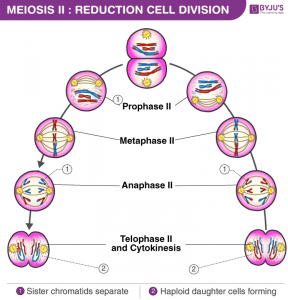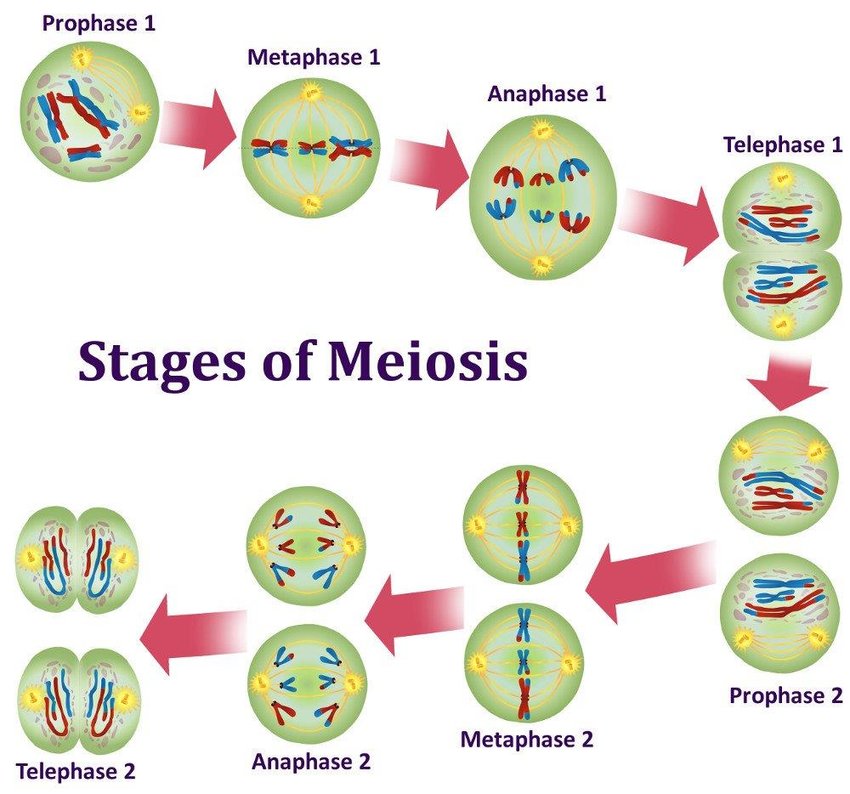Meiosis describes the process of cell division by which gametes are formed. In this process, we start with a cell with twice the normal amount of DNA and end up with 4 non-identical haploid daughter gametes after two divisions. There are six stages of Meiosis within each of the divisions, namely prophase, prometaphase, metaphase, anaphase, telophase, and cytokinesis. In this article, we will look at the stages of meiosis and consider their importance in disease.
Meiosis I
In meiosis I, the homologous chromosomes separate in two cells, so that there is one chromosome (consisting of two chromatids) per pair of chromosomes in each daughter cell, that is, two chromosomes in all.
Prophase I
Before prophase, the chromosomes replicate to form sister chromatids. Initially, there are four chromatids (c) and two chromosomes (n) for each of the 23 pairs of chromosomes (4c, 2n). The nuclear envelope disintegrates and the chromosomes begin to condense. Spindle fibres appear that are important for the successful division of chromosomes.
To further increase genetic diversity, homologous chromosomes swap small parts of themselves, so that one chromosome contains both maternal and paternal DNA. This process is known as crossing over, and the points where this occurs on a chromosome are called chiasmata.
Prometaphase I
Spindle fibres attach to chromosomes at points along the chromosomes called centromeres. As this happens, the chromosomes continue to condense.
Metaphase I
Maternal and paternal versions of the same chromosome (homologous chromosomes) line up along the equator of the cell. A process called independent assortment occurs: This is when the maternal and paternal chromosomes line up randomly on either side of the equator. This in turn determines which gamete chromosomes are assigned to, leading to genetic diversity among offspring.
Anaphase I
Here, each of the homologous chromosomes is drawn to opposite poles of the cell as the spindle fibres retract. This equally divides the DNA between the two cells that will form.
Telophase I and Cytokinesis I
During telophase, I, the nuclear envelope reforms and the spindle fibres disappear. In cytokinesis I, the cytoplasm and the cell divide result in two cells that are technically haploid: there is one chromosome and two chromatids for each chromosome (2c, n).
Meiosis II
Prophase II and Prometaphase II
These stages are identical to their counterparts in meiosis I.

Metaphase II
In metaphase II, the chromosomes line up in a single file along the equator of the cell. This is in contrast to metaphase I, where the chromosomes line up in homologous pairs.
Anaphase II
Sister chromatids are then attracted to opposite poles of the equator.
Telophase II
This stage is the same as telophase I.
Cytokinesis II
Again, the cytoplasm and the cell divide produce 2 non-identical haploid daughter cells. Since this happens in both cells produced by meiosis I, the net product is 4 non-identical haploid daughter cells, each containing a chromosome consisting of one chromatid (1c, 1n). These are fully formed gametes.

